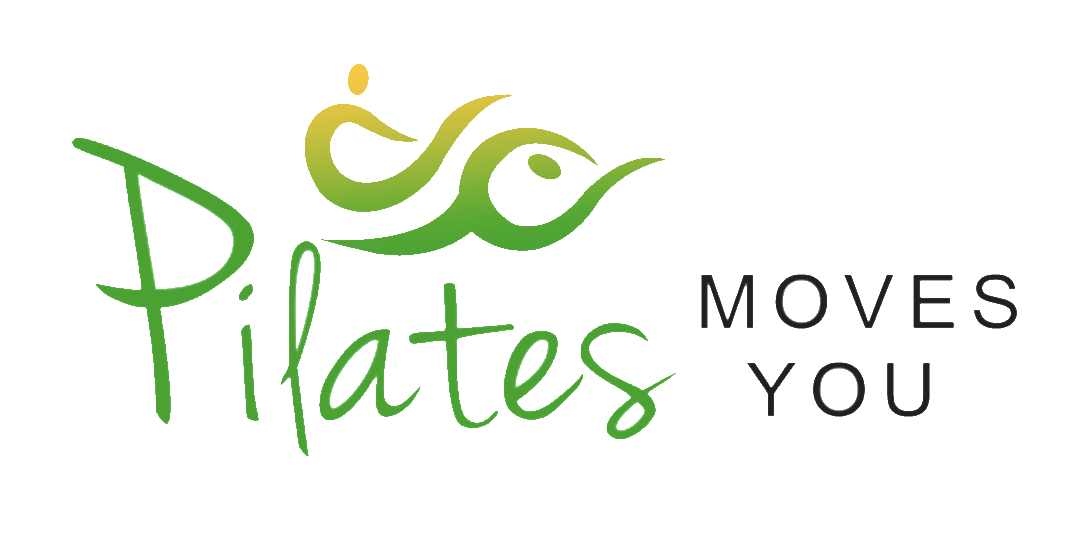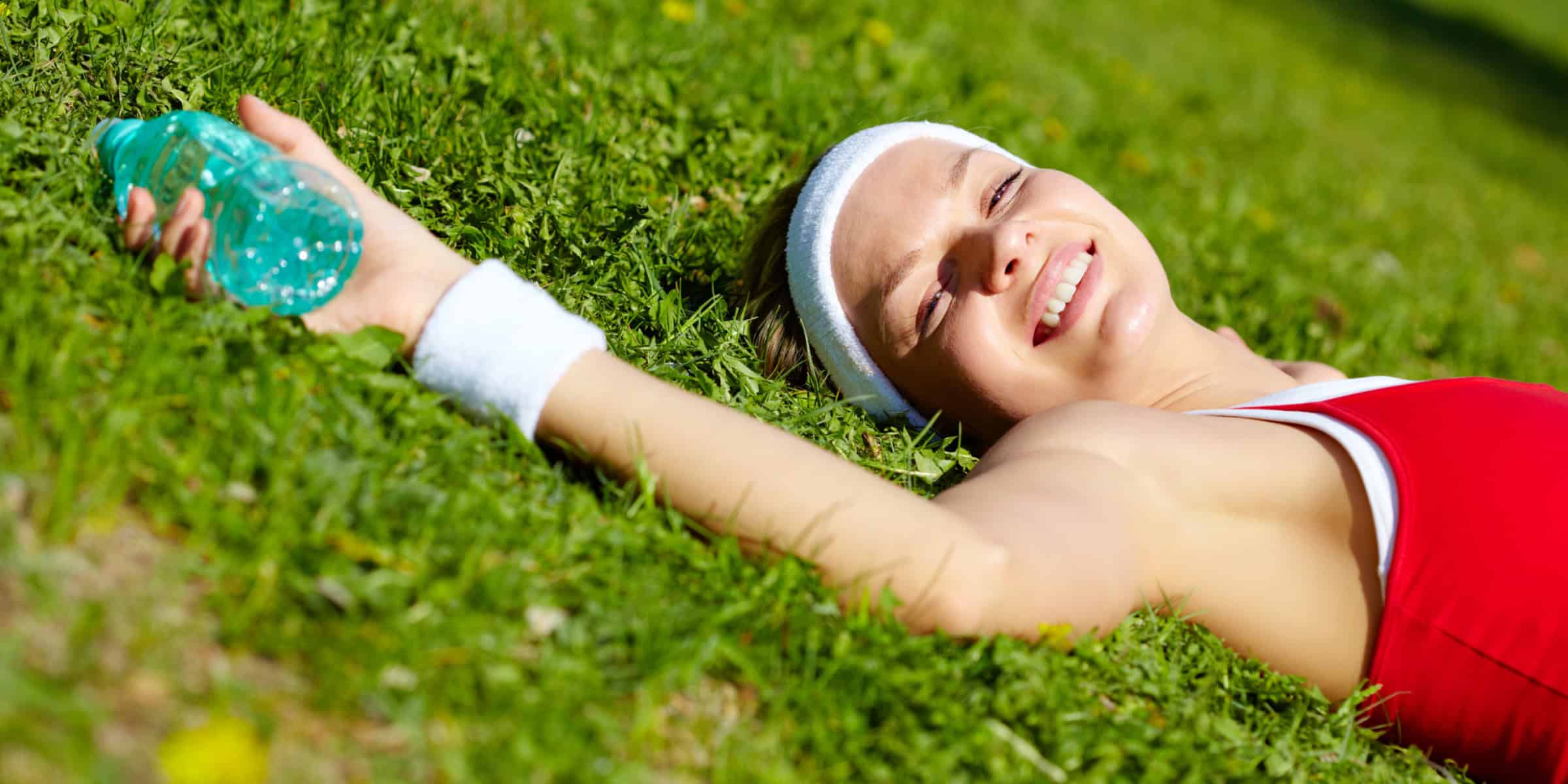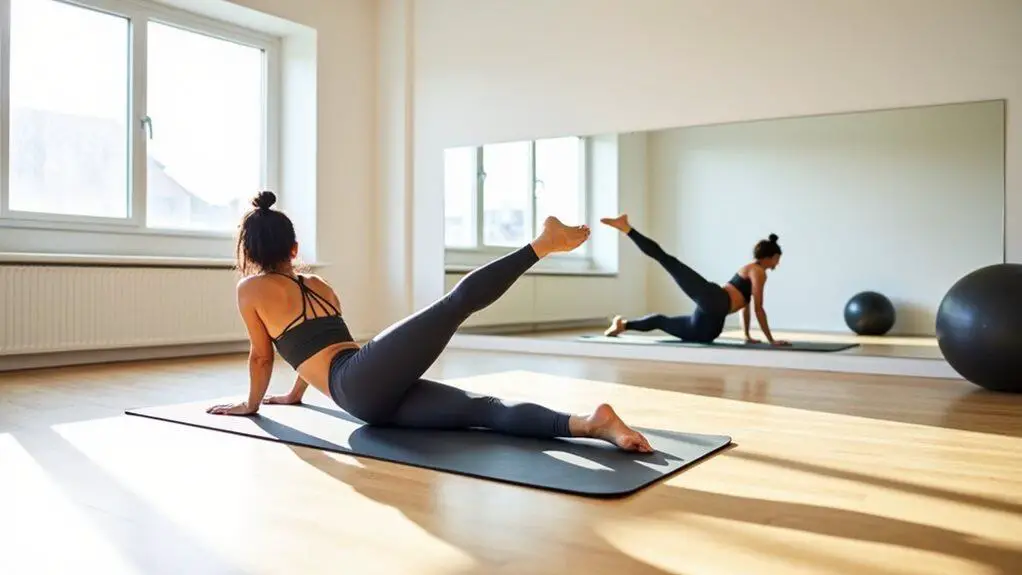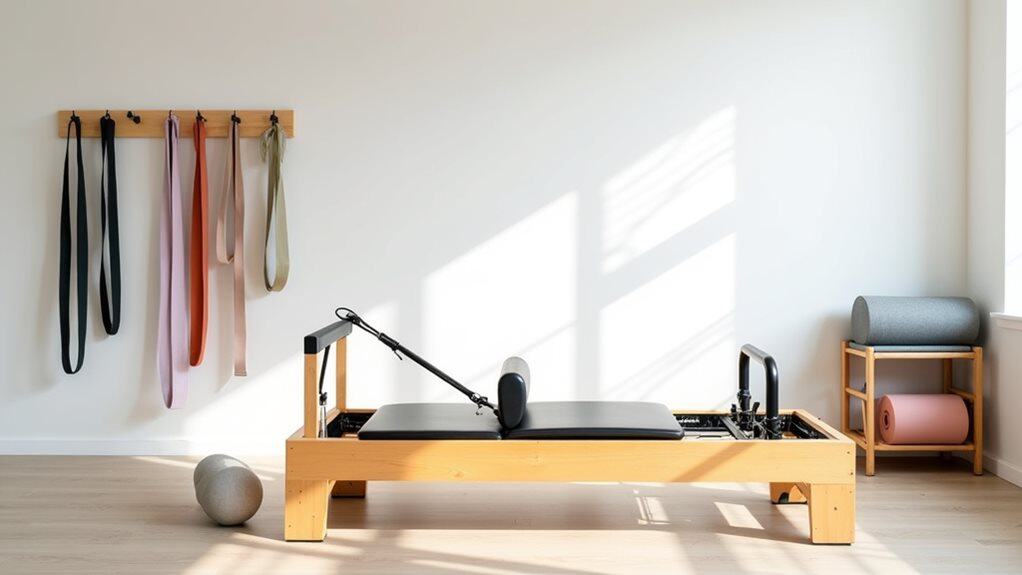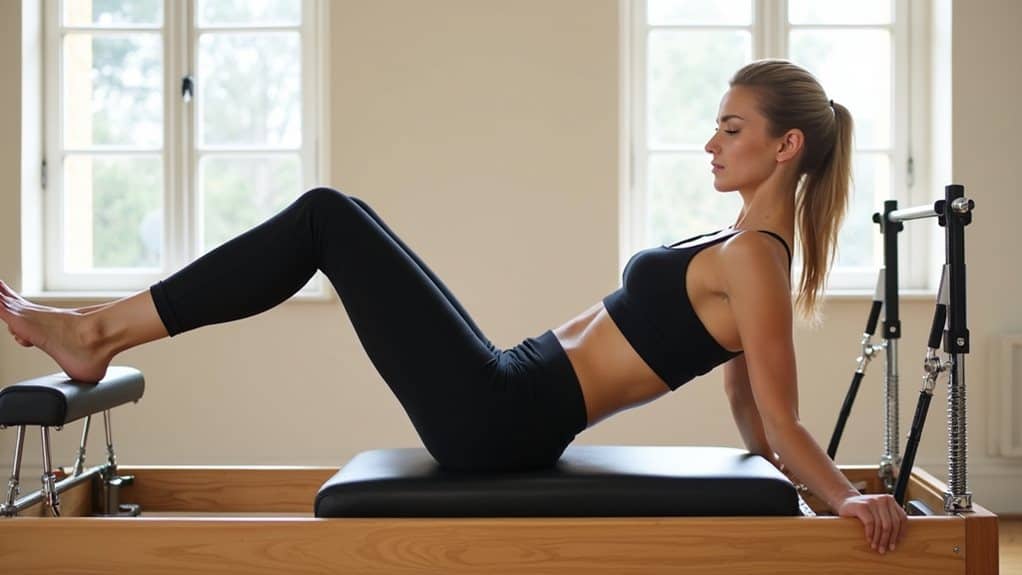Are you feeling overwhelmed and stressed? Do you long for a way to find relief and relaxation in your busy life?
Pilates may be the solution you’ve been searching for. Now, before you dismiss it as just another exercise fad, let’s address the elephant in the room: you might be thinking, ‘How can Pilates possibly help me find freedom from stress?’
Well, my friend, let me tell you. Pilates is not just about physical fitness; it’s a mind-body practice that can bring peace and tranquillity to your hectic world. By combining gentle movements with focused breathing and mindfulness techniques, Pilates allows you to release tension, improve flexibility, and restore balance to your body and mind.
In this article, we will explore the power of Pilates for stress relief and relaxation, and show you how to incorporate it into your daily routine for a greater sense of freedom and well-being. Get ready to discover a new path to inner calm and serenity with Pilates.
The Mind-Body Connection in Pilates
Discover how your mind and body work together in Pilates to create a calming and rejuvenating experience. Pilates is more than just a physical exercise; it’s a mindful practice that promotes mental well-being. By integrating mindfulness practices into your Pilates routine, you can achieve a greater sense of relaxation and stress relief.
During a Pilates session, you’re encouraged to focus on your breath, body alignment, and movement. This level of concentration helps quiet the mind and brings a sense of peace and presence. By being fully present in the moment, you can let go of stress and worries, allowing your body to relax and rejuvenate.
The mind-body connection in Pilates is further enhanced by the emphasis on core strength and stability. As you engage your core muscles, you’re also engaging your mind, bringing awareness to your body’s movements. This integration of mind and body promotes a sense of harmony and balance.
Incorporating mindfulness practices into your Pilates routine can have numerous benefits for your mental well-being. It can help reduce anxiety and stress, improve focus and concentration, and enhance overall mood and emotional well-being. By nurturing the mind-body connection in Pilates, you can experience a greater sense of freedom and inner peace.
Strengthening and Stretching for Stress Relief
In this discussion, you’ll explore how strengthening and stretching exercises in Pilates can help you build core strength and stability. By engaging your core muscles, you can develop a strong foundation that supports your body and helps alleviate stress.
Additionally, Pilates can also help increase your flexibility and range of motion, allowing you to move more freely and release tension in your muscles.
Build Core Strength and Stability
Strengthen your core and find stability in your life with Pilates – it’s like building a solid foundation for a stress-free mind and body.
Pilates is a form of exercise that focuses on developing core strength and improving stability. By engaging the deep muscles of your abdomen, back, and pelvis, Pilates helps build endurance and stability, allowing you to move with ease and confidence.
Here are three ways Pilates can help you build core strength and stability:
- Control: Pilates emphasizes precise and controlled movements, which require a strong core. By practicing Pilates regularly, you can improve your ability to control your body’s movements, leading to better stability.
- Balance: Pilates exercises often involve balancing on unstable surfaces or using equipment like a stability ball. This challenges your core muscles to work harder to maintain balance and stability.
- Flexibility: A strong core is essential for good posture and flexibility. Pilates helps lengthen and strengthen the muscles surrounding your spine, allowing for greater flexibility and improved stability.
Take the time to incorporate Pilates into your routine, and you’ll see how it can build your core strength and bring stability to your life.
Increase Flexibility and Range of Motion
Improve your overall flexibility and range of motion by incorporating Pilates into your fitness routine. Pilates exercises focus on stretching and lengthening the muscles, helping to increase flexibility and improve joint mobility. By regularly practicing Pilates, you can enhance your body’s ability to move freely and comfortably.
In addition to physical benefits, Pilates can also improve stress management and increase mental clarity. The controlled movements and focus on breath work in Pilates can help to calm the mind and promote relaxation. This can be particularly beneficial for individuals who are looking for a form of exercise that not only strengthens the body but also provides a sense of mental peace and tranquillity.
Here are some of the benefits of Pilates for flexibility and range of motion:
- Increased muscle flexibility
- Improved joint mobility
- Enhanced body movement
- Greater range of motion
- Better overall physical performance
Incorporating Pilates into your fitness routine can be a great way to improve your flexibility, enhance your range of motion, and find a sense of peace and relaxation. So why not give it a try and experience the benefits for yourself?
Creating a Peaceful Space for Practice
To create a peaceful space for your practice, it’s important to set up a comfortable and calming environment. Find a quiet area where you can relax and focus without any distractions.
Arrange your space with soft lighting, comfortable pillows or cushions, and any props or tools you may need for your practice. Additionally, consider using relaxing music or guided meditations to enhance the soothing atmosphere and help you unwind.
Set Up a Comfortable and Calming Environment
Creating a cozy and soothing atmosphere is essential for a successful and enjoyable Pilates practice, even if you think you don’t have enough space in your home. Mindful breathing and creating a serene space go hand in hand when it comes to relieving stress and finding relaxation through Pilates. To set up a comfortable and calming environment, consider the following tips:
- Lighting: Use soft and warm lighting, such as candles or dimmed lamps, to create a peaceful ambiance.
- Music: Choose calming instrumental music or nature sounds to enhance the relaxation experience.
- Scents: Incorporate aromatherapy by using essential oils or scented candles with soothing scents like lavender or chamomile.
By incorporating these elements, you can create a tranquil space that promotes relaxation and allows you to fully immerse yourself in your Pilates practice. Remember, finding a peaceful environment is essential for finding inner freedom and achieving optimal stress relief through Pilates.
Use Relaxing Music or Guided Meditations
Now that you’ve set up a comfortable and calming environment for your Pilates practice, it’s time to enhance your relaxation experience with the use of relaxing music or guided meditations.
Music has the power to soothe your mind and transport you to a place of tranquility. Choose soft, instrumental melodies or gentle, ambient sounds that resonate with you. Let the music flow through your body, allowing it to release any tension or stress that you may be holding onto.
As you move through your Pilates routine, synchronize your movements with the rhythm of the music, creating a harmonious connection between your mind and body. Additionally, incorporating deep breathing techniques while listening to the music can further enhance your relaxation experience. Take slow, deep breaths, allowing your body to fully relax with each exhale.
Embrace the freedom that comes with immersing yourself in this serene environment and enjoy the rejuvenation it brings to your mind, body, and soul.
Incorporating Mindfulness into Your Pilates Practice
To enhance your Pilates practice, it’s important to incorporate mindfulness into your movements and cultivate body awareness. By focusing on your breath and body sensations, you can bring a greater sense of presence and intention to your practice.
Additionally, cultivating gratitude and positive intentions can help create a positive mindset, enhancing the overall benefits of your Pilates practice.
Practice Mindful Movement and Body Awareness
Immerse yourself in the present moment by practicing mindful movement and developing a deep awareness of your body. Begin your Pilates session by focusing on your breath, using mindful breathing techniques to bring your attention to the present.
As you move through each exercise, take the time to scan your body, noticing any areas of tension or discomfort. By bringing your awareness to these areas, you can make adjustments to your form and alignment, allowing for a greater sense of ease and relaxation.
Pay attention to the sensations in your muscles and joints, and listen to your body’s cues. Mindful movement in Pilates can help you release stress and tension, promote better posture, and improve overall body awareness.
Give yourself the freedom to fully experience each movement, and let go of any distractions or worries.
Cultivate Gratitude and Positive Intentions
Take a moment to appreciate the blessings in your life and set positive intentions for your practice, allowing gratitude to fill your heart and guide your movements.
Cultivating a gratitude practice during your Pilates session can enhance your overall experience and promote relaxation and stress relief.
Begin by acknowledging the things you’re grateful for, whether it’s your health, the support of loved ones, or simply the opportunity to engage in this practice.
As you move through each exercise, repeat positive affirmations to yourself, such as “I’m strong,” “I’m capable,” and “I’m grateful for this moment.”
By incorporating gratitude and positive intentions into your Pilates routine, you create a space for freedom and peace within yourself.
Embrace the power of gratitude and let it infuse your practice with positivity and joy.
Breathing Techniques for Relaxation
Breathe deeply and let your body and mind unwind as you discover the power of incorporating breathing techniques into your Pilates practice. Deep breathing is a fundamental aspect of Pilates that not only helps to increase oxygen flow, but also promotes relaxation and stress relief. By incorporating meditation techniques into your breathing practice, you can enhance the mind-body connection and experience a greater sense of freedom.
Here are four breathing techniques that can bring a sense of calm and relaxation to your Pilates practice:
- Belly Breathing: Focus on breathing deeply into your belly, allowing it to rise and fall with each breath. This technique helps to activate the diaphragm and promote relaxation.
- Box Breathing: Inhale for a count of four, hold for a count of four, exhale for a count of four, and hold for a count of four. This technique helps to regulate your breath and calm the nervous system.
- 4-7-8 Breathing: Inhale for a count of four, hold for a count of seven, and exhale for a count of eight. This technique helps to slow down the breath and induce a state of relaxation.
- Alternate Nostril Breathing: Close one nostril with your finger and inhale deeply through the other nostril. Then, switch nostrils and exhale through the opposite nostril. This technique helps to balance the energy in the body and promote a sense of calm.
Incorporating these breathing techniques into your Pilates practice can help you release tension, reduce stress, and experience a greater sense of freedom and relaxation. Take the time to explore and experiment with different techniques to find what works best for you.
Finding Balance and Centering in Pilates
In order to find balance and centering in Pilates, it’s important to focus on improving your posture and alignment. By practicing proper alignment, you can prevent injuries and improve your overall physical well-being.
Additionally, Pilates helps to enhance the body-mind connection, allowing you to become more aware of your body and its movements. This leads to increased control and precision in your exercises.
Improve Posture and Alignment
Slouching in your chair all day at work can lead to poor posture and alignment, but with Pilates, you can discover a new way to sit that brings balance and ease to your body. Pilates focuses on improving flexibility and maintaining proper posture, which can have a positive impact on your overall well-being. Here are five ways Pilates can help improve your posture and alignment:
- Strengthen your core muscles: Pilates exercises target your deep core muscles, including the abdominals and back muscles, which are essential for maintaining good posture.
- Lengthen your spine: Pilates encourages lengthening of the spine, helping to counteract the effects of slouching and promoting a more upright posture.
- Improve body awareness: Through Pilates, you become more aware of your body and its alignment, allowing you to make conscious adjustments to improve your posture.
- Enhance muscle balance: Pilates exercises work on balancing the muscles on both sides of your body, helping to correct any imbalances that may contribute to poor posture.
- Decrease muscle tension: By stretching and strengthening the muscles used for maintaining posture, Pilates can help relieve muscle tension and promote a more relaxed and aligned body.
Incorporating Pilates into your routine can help you improve your posture and alignment, leading to a body that feels more balanced and at ease.
Enhance Body-Mind Connection
Now that you’ve learned how Pilates can help improve your posture and alignment, let’s move on to the next benefit: enhancing your body-mind connection.
Pilates isn’t just a physical exercise; it’s a mind-body practice that focuses on developing body awareness and mindfulness. By engaging in Pilates, you can cultivate a deeper understanding of your body and its movements, allowing you to connect with yourself on a more profound level.
Through mindful movements and controlled breathing, Pilates helps you become more present in the moment and increases your ability to manage stress. The combination of physical exercise and mental focus promotes relaxation and reduces tension in both your body and mind.
By incorporating Pilates into your routine, you can gain the tools to better manage stress and find a sense of freedom and calmness in your daily life.
Pilates Exercises for Stress Reduction
One effective way to relieve stress and promote relaxation is by incorporating Pilates exercises into your routine. Pilates for anxiety management is a popular practice that focuses on deep breathing, mindful movement, and gentle stretching to help calm the mind and release tension in the body.
These exercises can be done at home or even at work, making them a convenient option for stress reduction during a busy day.
When it comes to Pilates for stress reduction at work, there are several exercises that can be easily incorporated into your daily routine. One such exercise is the seated spine twist. This exercise helps to release tension in the spine and improve flexibility.
Another great exercise is the shoulder bridge, which targets the back, glutes, and hamstrings, helping to relieve tension in these areas.
In addition to these exercises, you can also incorporate deep breathing techniques into your Pilates practice. Breathing deeply and fully can help to activate the body’s relaxation response, reducing stress levels and promoting a sense of calm.
By incorporating Pilates exercises into your routine, you can effectively manage anxiety and reduce stress levels. Whether you choose to practice at home or at work, these exercises can provide a much-needed break from the demands of everyday life, promoting relaxation and overall well-being.
Progressive Relaxation Techniques in Pilates
In this section, you’ll learn about three key techniques in progressive relaxation: Progressive Muscle Relaxation Exercises, Guided Imagery, and Visualization. These techniques are commonly used in Pilates to promote stress reduction and relaxation. By incorporating these techniques into your Pilates practice, you can enhance your ability to release tension and achieve a state of deep relaxation.
Progressive Muscle Relaxation Exercises
By practicing progressive muscle relaxation exercises, you can effectively alleviate stress and promote a deep sense of relaxation throughout your body. These exercises involve tensing and then releasing specific muscle groups, allowing you to become more aware of tension in your body and learn to release it.
To fully benefit from these exercises, it’s important to combine them with deep breathing techniques. Here are three key benefits of incorporating progressive muscle relaxation exercises into your Pilates routine:
- Deep breathing: Deep breathing helps to increase oxygen flow in your body, promoting relaxation and reducing stress levels.
- Tension release: By consciously tensing and then releasing specific muscle groups, you can release accumulated tension and promote a state of relaxation.
- Mind-body connection: Progressive muscle relaxation exercises enhance your mind-body connection, allowing you to become more in tune with your body’s signals and needs.
Incorporating these exercises into your Pilates routine won’t only help you relieve stress but also enhance your overall well-being.
Guided Imagery and Visualization
Imagine yourself in a peaceful meadow, surrounded by vibrant flowers and a gentle breeze, as you close your eyes and engage in guided imagery and visualization techniques to enhance your overall well-being.
Guided imagery is a relaxation technique that involves using your imagination to create a mental image of a calming and peaceful place. By visualizing yourself in this serene environment, you can evoke positive emotions and reduce stress.
Visualization techniques can also be used to achieve specific goals or outcomes, such as improving performance or managing anxiety. Research has shown that practicing guided imagery and visualization regularly can have a profound impact on your mental and physical health.
So take a moment to imagine yourself in that tranquil meadow and allow yourself to experience the freedom and relaxation that guided imagery can provide.
Incorporating Pilates into Your Daily Routine
Kickstart your day with a Pilates routine that weaves stress relief and relaxation seamlessly into your daily schedule, like a gentle breeze flowing through your busy life. Incorporating Pilates into your daily routine can help you cultivate mindfulness and gratitude while benefiting your physical and mental well-being.
Here are four ways to incorporate Pilates into your daily routine:
- Wake up with Pilates: Start your day with a short Pilates routine to awaken your body and mind. Engage in gentle stretching, mindful movement, and deep breathing exercises to set a positive tone for the day ahead.
- Midday break: Take a break from your busy schedule by incorporating a Pilates session into your lunch break. This’ll help you release tension, refresh your mind, and boost your energy levels for the rest of the day.
- Post-work relaxation: Wind down after a long day by practicing Pilates exercises that focus on relaxation and stress relief. This’ll help you release any built-up tension and promote a sense of calmness and tranquility.
- Bedtime routine: End your day on a peaceful note by incorporating Pilates into your bedtime routine. Gentle stretches and relaxation exercises’ll help you unwind, promote better sleep, and prepare you for a restful night.
By incorporating Pilates into your daily routine, you can experience the benefits of mindful movement and cultivate gratitude while finding freedom from stress and tension.
Not sure when would be best? Check out my article on the best time of day to do Pilates.
Conclusion
In conclusion, incorporating Pilates into your daily routine can provide you with a powerful tool for stress relief and relaxation. By strengthening and stretching your body, practicing mindfulness, and incorporating breathing techniques, you can create a peaceful space for practice and find balance and centering in your life.
For example, a recent study conducted at a Pilates studio found that participants who practiced Pilates regularly experienced a significant decrease in stress levels and reported feeling more relaxed and at ease in their daily lives.
So why not give Pilates a try and experience the benefits for yourself?
Sources
https://informedrelaxation.com/how-to-practice-belly-breathing-for-relaxation/
https://informedrelaxation.com/which-is-better-chest-breathing-vs-belly-breathing/
